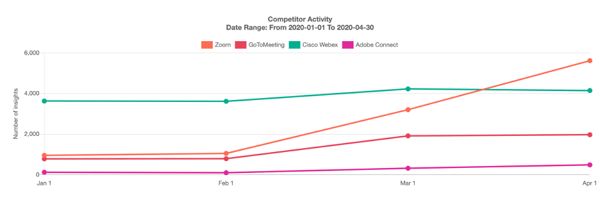Product marketers have a lot on their plates during a period of normalcy. During an atypical time when markets are in constant flux, and competitive pivots are just as swift, those plates are filled further. As the reconcilers of go-to-market and product strategies, formulating responses to market and competitive developments can feel overwhelming. Product development pivots, new marketing/PR campaigns, fresh sales strategies, messaging shifts - the possible responses to this market are endless.
The difficulty of product marketing’s breadth is zeroing in on what will make the greatest impact given limited bandwidth/resources. During times of rapid market fluctuations, pandemic-induced or otherwise, there are three areas of focus product marketers should prioritize: messaging & positioning shifts, product pivots, and sales differentiation. Each of these requires establishing and maintaining a firm grip on everything happening in your market. We’ll walk through what to keep track of in the market and how product marketers can leverage that information in those three key areas without overextending their limited capacity.
Market Mayhem
Movements in your market are difficult enough to keep track of under ordinary circumstances. Right now, the pace of change is higher than ever before. The graph below visualizes how four major players in the video conferencing industry have ramped up their volume of market-facing activity.

The data points in this graph encompass messaging changes, marketing campaigns, product pivots, headcount changes, and much more. Between the four companies, the total activity levels in March are nearly double that of February, and the trend continues into April. While this phenomenon is particularly evident in the video conferencing industry, it holds true even in industries only tangentially impacted by this unique market. As changes happen to the market on a macro level, businesses respond in a myriad of ways - some important to you, some not so much. Turn your focus to a few key areas within the broad categories of market intel and competitive intel.
Market Intelligence
Macroeconomic Trends: Broader changes in the economy will impact buyer behavior, drivers of value, and the health of your customer base.
Industry-Specific Changes: Certain industries are more uniquely impacted by this situation than others. Understanding how the industries in which you operate are being impacted will help inform your response strategies. For example, if you operate within the retail industry, gain and maintain an understanding of how spending is shifting to ecommerce vs. in-store.
Governmental/Policy Developments: While this is particularly relevant for organizations that work with the government, policy changes are important for everyone right now. It’s important to keep track of how new laws and regulations are impacting your industry.
Competitive Intelligence
Pricing/Packaging Changes: Keep a careful eye on your competitors’ pricing and packaging. Changes to new business and existing customer pricing are particularly common during times of financial hardship.
Messaging/Positioning Shifts: Empathetic organizations are shifting their messaging right now to address everything happening in the market. To stay differentiated, watch your competitors’ websites, press statements, and marketing campaigns like a hawk.
M&A/Funding Activity: This is particularly important information for executive leadership to know as soon as possible. A major competitor being acquired or reaching for funding can signal major changes to your market.
Maintaining a grip on all of the above can be difficult, but doing so puts you in a position to more easily and effectively address several key focus areas. Chief among those is messaging and positioning.
Messaging & Positioning Shifts
A chaotic market should not give way to an overly-reactive shift in your core messaging. Instead, it presents opportunities to make timely alterations that grab buyers’ attention. Now more than ever, your messaging needs to be both empathetic to the newly evolving needs of your customers and conscious of the dramatic surge in competitive messages. An excellent example of a product that has shifted a component of its core message in that manner is Microsoft Teams.

While the core value prop and messaging of Microsoft Teams remains unchanged, Microsoft is taking advantage of two key developments in their market: the increased need for teams to stay connected in a remote world, and the difficulty Zoom has had with privacy and security. This is reflected in their new homepage messaging and in many of their new marketing campaigns.
Product Pivots
Much like messaging, changing your overall product strategy in a time of crisis should be a last resort. Only if your customer needs or your competition pivots in a way that alters your core value proposition should you consider a drastic change.
Focus on smaller changes that address pressing customer needs in a differentiated manner. One of the simplest ways to do this is making temporary changes to pricing and/or packaging.
HubSpot works with businesses of all sizes. This includes small businesses, which are facing particularly difficult headwinds in this market. To address this, HubSpot lowered the price and included more features in their small business package. This is a move that both cements HubSpot as a more dominant player in the small business segment and is empathetic to the current needs of that small business segment.


Sales Differentiation
Sales teams are facing strong headwinds right now. Their buyers are slashing budgets, altering procurement processes, and examining every dollar spent much more closely. As a product marketer, you can’t do anything about budget reductions. Ensuring your sales team doesn’t lose any of those limited dollars to competitors, however, is entirely within your power.
If your sales team is still operating without the support of competitor battlecards, now is the time to remedy that. Battlecards can help sales reps improve their competitive win rate by 50% or more. Make sure you’re keeping the intel within those battlecards as up-to-date as possible, given the rapidly evolving nature of the market right now. Outdated intel is a surefire way to lose continued battlecard adoption.
Regular updates on the market and your competitive landscape are also particularly helpful right now. Consider sending a weekly or monthly newsletter-style update on major trends in your industry. This will be helpful to any market-facing team.
Whatever your plan of action is during these challenging market conditions, make sure you’re keeping a firm grip on everything happening in the market. Doing so will help you provide your customers with differentiated value. Product marketers are uniquely positioned to guide organizations through this obstreperous market. While it can be a difficult endeavor, it also provides the opportunity to help your customers and colleagues when they need it most.

Seeing is believing! Check out Crayon for yourself.
Take a Product TourRelated Blog Posts
Popular Posts
-
 The 8 Free Market Research Tools and Resources You Need to Know
The 8 Free Market Research Tools and Resources You Need to Know
-
 6 Competitive Advantage Examples From the Real World
6 Competitive Advantage Examples From the Real World
-
 How to Create a Competitive Matrix (Step-by-Step Guide With Examples + Free Templates)
How to Create a Competitive Matrix (Step-by-Step Guide With Examples + Free Templates)
-
 24 Questions to Consider for Your Next SWOT Analysis
24 Questions to Consider for Your Next SWOT Analysis
-
 How to Measure Product Launch Success: 12 KPIs You Should Be Tracking
How to Measure Product Launch Success: 12 KPIs You Should Be Tracking



